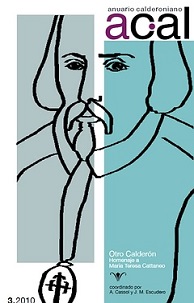El «Céfalo y Pocris» de Calderón entre reescritura y juego meta burlesco
Resumen
A partir de la premisa fundamental de la insuficiencia de un acercamiento puramente descriptivo a las comedias burlescas del Siglo de Oro, y de la necesidad de analizar cada texto de este género no sólo en sus caracteres convencionales de dramaturgia cómico-disparatada, el presente estudio intenta un análisis del carácter paródico y de las funciones literarias subyacentes en Céfalo y Pocris, la única comedia burlesca que nos queda de Calderón de la Barca. Subrayando la necesidad de detectar un más exacto nexo entre el hipertexto burlesco y su complejo hipotexto (donde priman las dos obras del propio Calderón, Celos, aun del aire, matan y Auristela y Lisidante), el estudio destaca el fuerte componente metateatral de la comedia. En fin, a partir de este elemento esencial de la obra, el estudio —haciendo hincapié en las ideas sobre la pintura que Calderón nos deja en su Tratado defendiendo la nobleza de la pintura— intenta demostrar cómo en Céfalo y Pocris el dramaturgo, en las continuas alusiones a la imaginación figurativa que el teatro comparte con la pintura, y a pesar del régimen cómico-burlesco, confirma los fundamentos estéticos y poéticos de su dramaturgia y de su cosmovisión.
«Calderón’s Céfalo y Pocris: between rewriting and a meta-burlesque game»
Starting from the fundamental premise of the insufficiency of a purely descriptive approximation to the Golden Age burlesque comedies, and the need to analyze each text of this genre not only through the conventional characters of comic-absurd playwriting, the present study aims for an analysis of the parody character and of the underl-ying literary functions in Céfalo y Pocris, the only burlesque comedy that we have from Calderón de la Barca. Underlying the necessity to detect a more exact link between the burlesque hypertext and its complex hipotext (where the two works of Calderón take precedence, Celos, aun del aire, matan and Auristela y Lisidante), the study highlights the strong meta-theatrical component of the comedy. Ultimately, through this essential element of the work, the study-stressing the ideas about painting that Calderón leaves us with in his Treaty defending the nobleness of painting-attempts to demonstrate how in Céfalo y Pocris the playwright, in continual allusions to the figurative imagination that theater shares with painting, and in spite of the comic-burlesque regime, confirms the aesthetic and poetic foundations of his playwriting and his worldview.
PALABRAS CLAVE / KEYWORDS: Calderón, Céfalo y Pocris, reescritura, juego / Calderón, Céfalo y Pocris, rewriting, game
Descargas
Cómo citar
Número
Sección
Licencia
Política propuesta para revistas que ofrecen acceso abierto diferido
Aquellos autores/as que tengan publicaciones con esta revista, aceptan los términos siguientes:
- Los autores/as conservarán sus derechos de autor y garantizarán a la revista el derecho de primera publicación de su obra [considerando un período de embargo editorial de 1 año], el cuál estará simultáneamente sujeto a la Licencia de reconocimiento de Creative Commons que permite a terceros compartir la obra siempre que se indique su autor y su primera publicación en esta revista.
- Los autores/as podrán adoptar otros acuerdos de licencia no exclusiva de distribución de la versión de la obra publicada (p. ej.: depositarla en un archivo telemático institucional o publicarla en un volumen monográfico) siempre que se indique la publicación inicial en esta revista y se considere el período de embargo.
- Se permite y recomienda a los autores/as difundir su obra a través de Internet (p. ej.: en archivos telemáticos institucionales o en su página web) antes y durante el proceso de envío, lo cual puede producir intercambios interesantes y aumentar las citas de la obra publicada.


